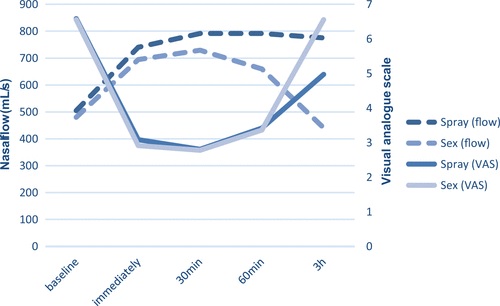| The Ig Nobel Prizes are an American parody of the Nobel Prize. They are awarded each year at the beginning of October to recognize the achievements of ten groups of scientists who "first make people laugh, and then they make them think." Organized by the scientific humor magazine Annals of Improbable Research (AIR), the awards are presented by a series of collaborators, including real Nobel Prize winners, in a ceremony organized at the Sanders Theater at Harvard University. «The awards aim to celebrate the unusual, honor the imaginative and stimulate everyone’s interest in science, medicine, and technology» |
Bulut et al. They found that sex could improve nasal congestion as effectively as nasal decongestants for up to 60 minutes, returning to baseline levels within three hours. Of course, a good 12-hour nasal spray would last much longer, but it’s less fun. And some people may experience adverse effects from nasal spray, so it would be helpful to have a natural replacement method for congestion. The authors hope there will be more studies to investigate whether masturbation has a similar effect.
A physiological connection between the nose and genitals has long been proposed. Wilhelm Fliess (1858-1928), an otolaryngologist practicing in Berlin, was the best friend and confidant of Sigmund Freud (1856-1939). “Reflex nasal neurosis ” was published by Fliess in 1897, postulating a physiological connection between the nose and the genitals. There would be specific “genital spots” , according to Fliess, located in the inferior nasal conchae that played an important role in the “naso-genital relationship”. Freud and Fliess developed this theory in letters to each other over the following years.
Sigmund Freud, who underwent inferior turbinate surgery twice for Fliess, even referred publicist Emma Eckstein for surgery, whom he diagnosed with a “nasal reflex neurosis.” The surgery ended in disaster, resulting in recurring nosebleeds and a disfigured nose. Fliess’s strange theories of neurosis never had scientific validity. Since then, reports on the naso-genital relationship have decreased in the medical literature.
The sympathetic and parasympathetic nerves innervate the vasculature and glands of the nasal mucosa with opposite actions. Parasympathetic nerves and their neurotransmitters cause mucus secretion and/or vasodilation. In contrast, sympathetic nerves and sympathetic neurotransmitters have little effect on mucus secretion, but constrict blood vessels in the nasal mucosa. It is very likely that the opposing actions of these systems determine the effect of nasal patency.7
It is known that physical exercise, as well as hormonal changes, can have an effect on short- and long-term nasal airway resistance. However, there are no studies investigating the effect of sexual activity on nasal breathing. This study was conducted to examine the impact of sexual activity on nasal breathing and compare the effect with nasal decongestant. Is "love" all you need to improve nasal breathing?
Goals:
This study was conducted to examine the impact of sexual activity on nasal breathing and to compare this effect with that of a nasal decongestant.
Methods:
We assessed nasal breathing at 5 different time points: (1) before sexual activity (baseline), (2) immediately after sexual activity, (3) 30 minutes, (4) 1 hour (5) and 3 hours after sexual climax.
The same measurements were taken on the second day after application of the nasal decongestant spray.
To evaluate nasal breathing, we used a visual analogue scale (VAS). Additionally, we use a portable rhinometric device to measure nasal flow and resistance.
Results:
Nasal breathing significantly improved after sexual intercourse with climax to the same degree as after application of nasal decongestants for up to 60 minutes, measured subjectively with the VAS (sex −3.6; p < 0.001; aerosol −3 .2; p < 0.001).
This was confirmed in objective rhinometric data, as mean nasal flow (ml/s) increased while resistance immediately decreased (flow sex +214, p < 0.001; flow spray +235, p < 0.001), 30 (flow sex +249, P < 0.001; spray flow +287, p < 0.001) and 60 minutes (flow sex +180, p < 0.001; spray flow +287, p < 0.001) after the intervention.
Nasal breathing returned to baseline after 3 hours after sexual intercourse, while it continued to improve longer after application of the nasal decongestant.
Only participants who had nasal obstruction (nasal obstruction symptom assessment score > 30) showed improved nasal function after sex.

Nasal breathing measured by VAS and rhinometric flow before and after the interventions (sexual activity and application of nasal decongestant spray). VAS indicates visual analog scale.
Discussion
Sexual intercourse with climax can improve nasal breathing to the same degree as the application of nasal decongestants for up to 60 minutes in patients with nasal obstruction.
We report improvement in nasal breathing after sexual intercourse for up to 60 minutes and to the same extent as application of nasal decongestants measured with subjective VAS.
This was confirmed by objective rhinometric data, as mean nasal flow increased while resistance decreased immediately, 30 minutes and 60 minutes after the intervention. Three hours after sexual intercourse, nasal breathing returned to baseline, while it remained improved for longer after the nasal decongestant. The effect was significant in patients with any pre-existing nasal obstruction (NOSE score > 30).
Conclusions: Climaxing sexual intercourse improves nasal breathing to the same degree as the application of nasal decongestants for up to 60 minutes, as measured by subjective VAS. This was confirmed by the mean of objective rhinometric data when nasal flow increased while resistance decreased immediately, 30 minutes and 60 minutes after the intervention. Three hours after sexual intercourse, nasal breathing returned to the baseline level in the "sexual group", while after application of the nasal decongestant spray, nasal breathing still improved significantly. Only participants who had nasal obstruction (NOSE score > 30) showed improvement after sex. |















